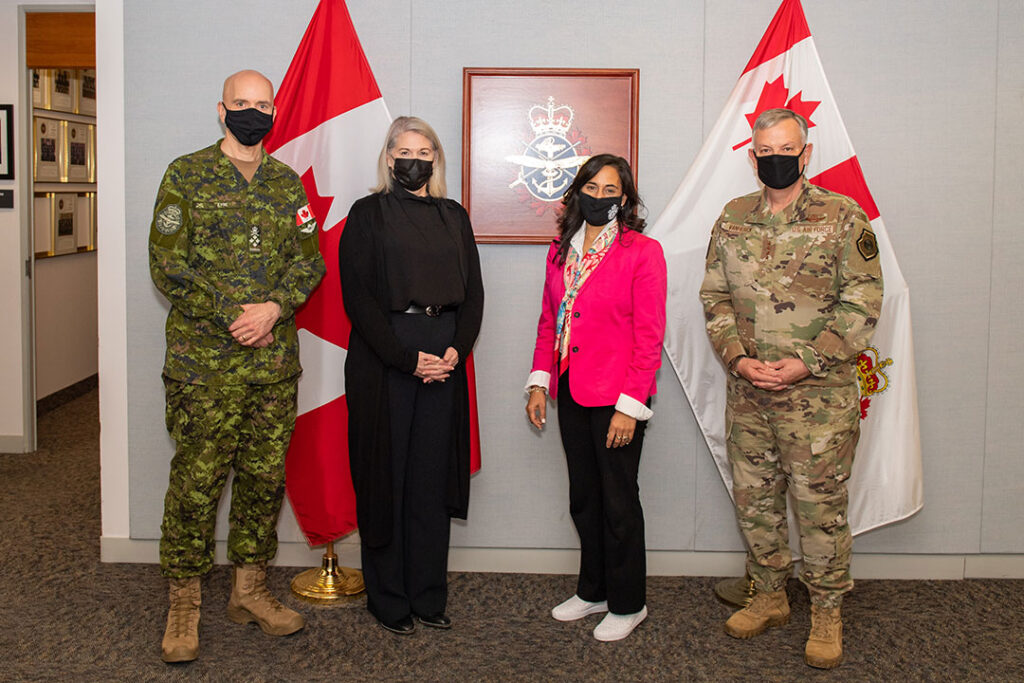THE WATCH STAFF
U.S. Air Force Gen. Glen VanHerck made his first trip to Canada as commander of North American Aerospace Defense Command (NORAD) and gave a threat assessment to the country’s military leaders that included risks from hypersonic missiles.
VanHerck, who heads NORAD and is also commander of U.S. Northern Command (USNORTHCOM), visited National Defence Headquarters in Ottawa on November 30, 2021 — the day after Russia announced it tested a hypersonic cruise missile. The Canadian Broadcasting Corp. (CBC) reported that VanHerck was candid in speaking about the challenge such missiles pose to NORAD, the binational command tasked with early warning and control of the continent’s airspace.
The Canadian Armed Forces posts personnel to NORAD headquarters at Peterson Space Force Base in Colorado Springs, Colorado, and at other locations across Canada and the U.S. Canada also keeps fighter aircraft on alert for NORAD and operates the Canadian portion of the North Warning System radar, according to a Canadian Armed Forces news release.
“As the commander of NORAD, I think probably the most important mission I do is provide threat warning and attack assessment for both Canada and the United States, for North America,” VanHerck told a media roundtable, according to the CBC. “Hypersonics will challenge my ability to do that going forward.”
That’s because NORAD’s string of 1980s-era radar installations is ineffective in detecting hypersonic weapons, a message that VanHerck told officials in Canada, according to a November 30, 2021, article in the country’s National Post newspaper.
“The North Warning System is designed for a threat from 50 years ago,” VanHerck said, according to the National Post. “A bomber that has to fly over the North Pole to drop gravity weapons has to fly over Canada and North America into the United States to drop any of those weapons.”
Hypersonic weapons are usually defined as those that fly at more than five times the speed of sound. The ability to travel at such a velocity extends the missiles’ range and allows them to bypass layered missile defenses, according to a 2018 overview by the Missile Defense Advocacy Alliance. The missiles are also difficult to track and intercept because they are capable of maneuvering while in flight.
Russia has already fielded hypersonic weapons, according to VanHerck.
“Russia’s the primary military threat to North America. China’s about a decade behind,” he said, according to the National Post.
The U.S. is conducting a Missile Defense Review for release in early 2022 that will address hypersonics. Ottawa, meanwhile, hasn’t laid out a clear position on what it would do to defend Canada from hypersonic weapons, according to the CBC.
VanHerck said that Canadian officials didn’t share any policy decisions on hypersonics with him during their meetings, the CBC reported. VanHerck said he briefed Defence Minister Anita Anand and Chief of Defence Staff Gen. Wayne Eyre about the hypersonic threat so they can determine “the way forward.”
(Pictured, from left: Canadian Gen. Wayne Eyre, Deputy Defence Minister Jody Thomas, Defence Minister Anita Anand and U.S. Gen. Glen VanHerck.)
VanHerck and his Canadian counterparts praised the unique partnership embodied in NORAD and its ability to adapt and respond to threats.
“With competitors now capable of striking discrete military targets and critical infrastructure in both Canada and the United States, the need for continued collaboration and support is key to the ongoing success of NORAD and the security of North America,” VanHerck said in a Canadian National Defence news release. “The discussions between Gen. Eyre and myself, as well as with the other civilian and military leaders with whom I met, assure a common perspective on continental defense, now and in the future.”
IMAGE CREDIT: CANADIAN ARMED FORCES

